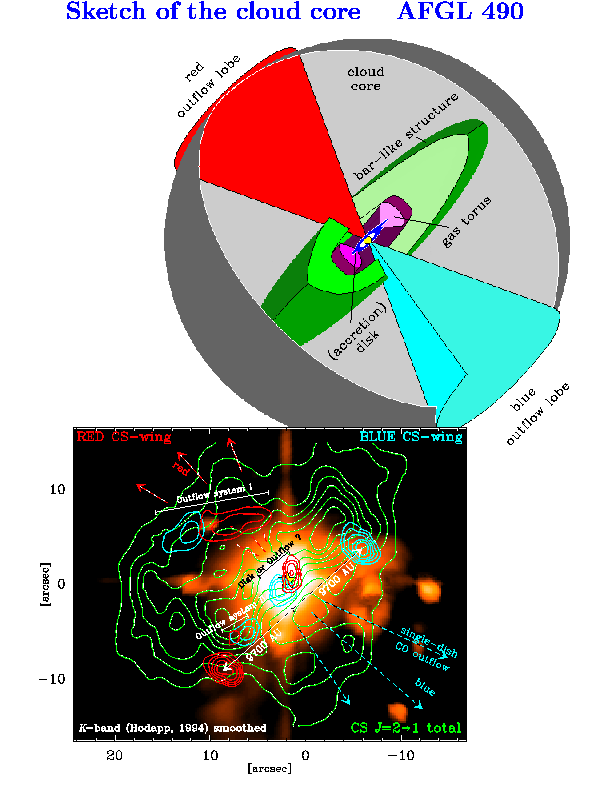A massive disk around AFGL 490

The formation of massive stars is one of the open problems in present research. Whether the dominant formation process for massive stars is disk accretion or coalescence remains an open question. Recent detections of disks around the massive B-type protostars IRAS 20126+4104 (Cesaroni et al. 1999, Zhang et al. 1998), G192.16-3.82 (Shepherd et al. 2001), and AFGL 490 (Schreyer et al. 2002) indicate that these disks are more massive and larger than disks around T Tauri and Herbig Ae stars.
Based on our data obtained with the Plateau de Bure Interferometer (France), we studied AFGL 490 in much more detail (see Schreyer et al. 2002). This object is a key target of the class of deeply embedded intermediate-mass young stellar objects in a transition stage to Herbig Be stars (L = 2.2-4.0x103 Lsun, M ~ 8(-10) Msun, spectral type B2-B3, D = 1kpc). Our PdBi (CS 2-1) line data show a bar-like elongated gas structure of 22000 AU x 6000 AU size with a position angle of ca. -45degree. This bar represents the flattened inner envelope surrounding a disk-like structure (radius
The combination of our PdBI data with infrared and 2cm VLA data by Bunn et al. (1994), Hoare et al. (1996 & 2001), & Campbell et al. (1986) strongly indicate that the central star of AFGL490 is located in a small ionized region with an accelerating stellar wind surrounded by an accretion disk with an outer radius smaller than 500 AU. The outer regions of this disk merge with a larger gas torus with radius < 4000 AU. This region is surrounded by the remnant of a flattened cloud core (r < 104 AU). All these structures together are embedded in a more extended envelope. A possible model is shown in the figure above. All known observational data with the present resolution do not suggest that the massive gas disk is a merger of multiple disks around multiple stars. The gas mass inside a radius of 4000 AU is about 8 Msun and similar to the mass of the central star. The mass estimates obtained for the continuum point source are somewhat lower with values between 3 and 6 Msun within a radius of ≤ 500 AU. In addition, Hoare et al. (1996 & 2001) reported a variability of the source extension in the NIR and at VLA-2cm in the same orientation as the possible disk. This is interpreted as a variability in the accretion onto the star which supports well the idea that such a massive disk cannot exist for a very long time without disruption due to its self-gravity. Adams et al. (1989) calculated that disks with Mstar ≈ Mdisk can be gravitationally unstable to eccentric matter displacements that have growth times comparable to the orbital period of the outer disk edge (103-104 yrs). The evolution of massive disks with a Toomre parameter of Qmin ~ 1 was studied by Laughlin & Bodenheimer (1994), who reported rapid fragmentation within a dynamical time scale (~103 yrs) in the inner regions of the disk. This rather short destruction time scale indicates that gravitational instabilities will be the most important destruction mechanism for more massive cirumstellar disks around massive young stars. Thus, we can speculate that the outer gas torus feeds the inner gravitationally unstable gas disk until the torus is depleted. Then, the gas torus and the disk disappear. This would be in a good agreement with the observations that Herbig Be stars (Natta et al. 2000, and more massive stars) have no disks anymore, and this would be a possible procedure to build up stars with masses - maybe - until 15 to 20 Msun. Here, more theoretical work and high-resolution observations are needed.
AFGL490 resembles in many aspects the source G192.16-3.82, where Shepherd et al. (2001) found a disk. However, AFGL490 has the advantage that it is located at half of the distance of this object and is thus perfectly suited for further interferometric observations.
For more details, see: "The young intermediate-mass stellar object AFGL 490 - A disk surrounded by a cold envelope" (Schreyer, Henning, van der Tak, Boonman, van Dishoeck 2002, A&A 394, p. 561).
